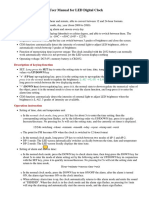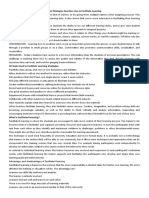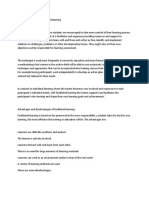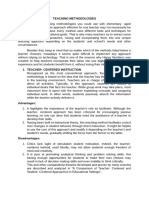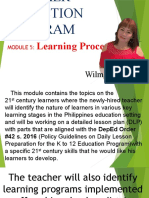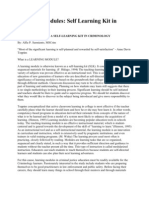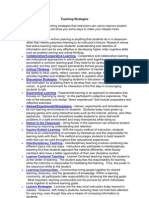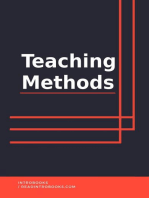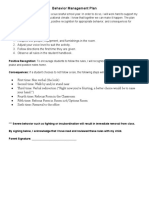0 ratings0% found this document useful (0 votes)
69 viewsBlending Learning
Blended learning combines online educational materials and opportunities for online interaction with traditional classroom learning. It has several key characteristics, including incorporating online and offline learning, instructor involvement, independent learning, and peer interaction. Blended learning is student-centered as it allows flexibility in pacing and provides instruction tailored to individual student needs. A blended approach also helps cater to different learning styles. While blended learning has advantages like increased student interest and autonomy, there are also challenges to consider such as technology expenses, training needs, and adapting content.
Uploaded by
afeesha charlesCopyright
© © All Rights Reserved
Available Formats
Download as DOCX, PDF, TXT or read online on Scribd
0 ratings0% found this document useful (0 votes)
69 viewsBlending Learning
Blended learning combines online educational materials and opportunities for online interaction with traditional classroom learning. It has several key characteristics, including incorporating online and offline learning, instructor involvement, independent learning, and peer interaction. Blended learning is student-centered as it allows flexibility in pacing and provides instruction tailored to individual student needs. A blended approach also helps cater to different learning styles. While blended learning has advantages like increased student interest and autonomy, there are also challenges to consider such as technology expenses, training needs, and adapting content.
Uploaded by
afeesha charlesCopyright
© © All Rights Reserved
Available Formats
Download as DOCX, PDF, TXT or read online on Scribd
You are on page 1/ 4
Blended Learning
What is blended learning?
Blending learning is an approach that takes into consideration both online
educational materials and opportunities for interactions online with the
combination of traditional classroom methods.
Characteristics of blended learning:
Some characteristics of blended learning include offering technology and other
types of support for students, helping them become independent learners and
letting them interact with their peers.
There is-
1. Online and offline learning
2. Instructor Involvement
3. Independent leaning
4. Peer Interaction
5. Support for students
Models of blended learning:
Why is blended learning student-centered?
When implemented correctly, a blended learning model is naturally
student-centered: by introducing technology and allowing for flexibility
in time, place, and pace of learning, students have more opportunities
to influence the way learning happens. Blended classrooms are about
giving students the instruction that they need at the moment they need
it, and in such a way that keeps them engaged and motivated. In short,
they’re all about student-centered learning.
How does blended learning approach caters to diversity?
Blended learning that uses apps, games, or measurable programs to teach
concepts allows students to engage the material at their own pace. ... It can
promote deeper learning, reduce stress, and increase student satisfaction.
Teachers can become more engaged with their students. . A blended learning
approach ensures that the learner is engaged and driving his or her individual
learning experience. This approach also helps cater to the individual needs of the
learner, most students have unique learning styles and a blended approach is
more likely to cater to those needs than a traditional classroom teaching
experience.
Management system that would ensure successful implementation
Advantages and disadvantages of blended learning.
Advantages
Increase student interest: when technology is integrated into school lessons,
learners are more likely to be interested in, focused on, and excited about the
subjects they are studying.
Provides student autonomy: The use of eLearning materials increases a student’s
ability to set appropriate learning goals and take charge of his or her own learning,
which develops an ability that will be translatable across all subjects.
Instill a disposition of self-advocacy: Students become self-driven and
responsible, tracking their individual achievements, which helps develop the ability
to find the resources or get the help they need, self-advocating so they can reach
their goals.
Disadvantages:
Some significant challenges to blended learning models include the expense of
technology, inadequate training, technological issues, the need to adapt content for
blended learning, decreased motivation, and weakened relationships between
students and teachers.
You might also like
- The Essentials of Technical Communication (Elizabeth Tebeaux, Sam Dragga)100% (10)The Essentials of Technical Communication (Elizabeth Tebeaux, Sam Dragga)390 pages
- Codi Byte - Chat GPT Bible - 10 Books in 1_ Everything You Need to Know About AI and Its Applications to Improve Your Life, Boost Productivity, Earn Money, Advance Your Career, And Develop New Skills.92% (25)Codi Byte - Chat GPT Bible - 10 Books in 1_ Everything You Need to Know About AI and Its Applications to Improve Your Life, Boost Productivity, Earn Money, Advance Your Career, And Develop New Skills.447 pages
- Self-Guided EMDR Therapy Workbook Healing From Anxiety, Anger, Stress, Depression, PTSD Emotional Trauma (Katherine Andler)100% (16)Self-Guided EMDR Therapy Workbook Healing From Anxiety, Anger, Stress, Depression, PTSD Emotional Trauma (Katherine Andler)54 pages
- Case Study 1.2 The Hokies Lunch Group - Edited67% (9)Case Study 1.2 The Hokies Lunch Group - Edited4 pages
- Dokumen - Pub - The Last Law of Attraction Book Youll Ever Need To Read The Missing Key To Finally Tapping Into The Universe and Manifesting Your Desires Paperbacknbsped 1701069288 978170106928294% (32)Dokumen - Pub - The Last Law of Attraction Book Youll Ever Need To Read The Missing Key To Finally Tapping Into The Universe and Manifesting Your Desires Paperbacknbsped 1701069288 9781701069282193 pages
- Mantak Chia - Awaken Healing Energy Through The Tao100% (77)Mantak Chia - Awaken Healing Energy Through The Tao195 pages
- Building Better Habits With The Habit Loop: 1. CUE 2. Craving91% (65)Building Better Habits With The Habit Loop: 1. CUE 2. Craving1 page
- Textbook of Modern Herbology Second Revised Edition100% (14)Textbook of Modern Herbology Second Revised Edition399 pages
- Foxfire 5 Ironmaking, Blacksmithing, Flintlock Rifles, - Wigginton100% (10)Foxfire 5 Ironmaking, Blacksmithing, Flintlock Rifles, - Wigginton516 pages
- Lesson Plan:: 6th:: Limba Moderna 1 Engleza, Uniscan, Jenny Dooley Past Simple of The Verb Have Got-HadNo ratings yetLesson Plan:: 6th:: Limba Moderna 1 Engleza, Uniscan, Jenny Dooley Past Simple of The Verb Have Got-Had4 pages
- Group Counseling Outline For Elementary Aged GirlsNo ratings yetGroup Counseling Outline For Elementary Aged Girls18 pages
- Lesson 4 Approaches, Methods of Teachng EPP60% (10)Lesson 4 Approaches, Methods of Teachng EPP6 pages
- EDUC 31 Unit 4 Lesson 9 Instructional Delivery Modalities FinalNo ratings yetEDUC 31 Unit 4 Lesson 9 Instructional Delivery Modalities Final11 pages
- Collaboration in Blended Learning Focus in The New Normal EducationNo ratings yetCollaboration in Blended Learning Focus in The New Normal Education13 pages
- Modern Teaching and Learning Approaches ..No ratings yetModern Teaching and Learning Approaches ..5 pages
- Clickers Enable Instructors To Rapidly CollectNo ratings yetClickers Enable Instructors To Rapidly Collect3 pages
- What is Differentiation in the classroom and 14cs of LCTNo ratings yetWhat is Differentiation in the classroom and 14cs of LCT22 pages
- Five Strategies Teachers Use To Facilitate LearninNo ratings yetFive Strategies Teachers Use To Facilitate Learnin3 pages
- Learner's Centred Approaches: An Overview: Learner-Centered Teaching Is An Approach To Teaching That IsNo ratings yetLearner's Centred Approaches: An Overview: Learner-Centered Teaching Is An Approach To Teaching That Is4 pages
- Implementing A Health Education Plan Charles Adiong PartNo ratings yetImplementing A Health Education Plan Charles Adiong Part7 pages
- Star of Hope International School Workshop for TeachersNo ratings yetStar of Hope International School Workshop for Teachers13 pages
- Ch#3: Role of Instructional & Communication Technology in Learning0% (1)Ch#3: Role of Instructional & Communication Technology in Learning12 pages
- Learning To Know Involves The Development of The Faculties of MemoryNo ratings yetLearning To Know Involves The Development of The Faculties of Memory5 pages
- Implications of Cognitive Learning Theory in Teaching and LearningNo ratings yetImplications of Cognitive Learning Theory in Teaching and Learning5 pages
- Strategies: UNESCO's 4 Pillars of EducatonNo ratings yetStrategies: UNESCO's 4 Pillars of Educaton5 pages
- Teaching Methods: Teacher-Centered Approach To LearningNo ratings yetTeaching Methods: Teacher-Centered Approach To Learning12 pages
- Implementing Blended Learning in An EFLNo ratings yetImplementing Blended Learning in An EFL12 pages
- Plant Healer 2020 Herbal Education Guide & Schools Directory100% (2)Plant Healer 2020 Herbal Education Guide & Schools Directory81 pages
- Beginning Singing by John Henny Download VersionNo ratings yetBeginning Singing by John Henny Download Version130 pages
- For The First Week of School: Jodi SouthardNo ratings yetFor The First Week of School: Jodi Southard6 pages
- CB English Ebook 6 Steps To Paraphrasing PDFNo ratings yetCB English Ebook 6 Steps To Paraphrasing PDF7 pages
- LESSON PLAN (World Class - Unit 24 - Revision)No ratings yetLESSON PLAN (World Class - Unit 24 - Revision)4 pages
- Directions in JCE Lesson Plan Supporting InformationNo ratings yetDirections in JCE Lesson Plan Supporting Information5 pages
- MS2 MS3 MS4 Levels Official Yearly Planning & Omitted Lessons87% (15)MS2 MS3 MS4 Levels Official Yearly Planning & Omitted Lessons15 pages
- Communicative and Performance-Based TestingNo ratings yetCommunicative and Performance-Based Testing5 pages
- The Essentials of Technical Communication (Elizabeth Tebeaux, Sam Dragga)The Essentials of Technical Communication (Elizabeth Tebeaux, Sam Dragga)
- Codi Byte - Chat GPT Bible - 10 Books in 1_ Everything You Need to Know About AI and Its Applications to Improve Your Life, Boost Productivity, Earn Money, Advance Your Career, And Develop New Skills.Codi Byte - Chat GPT Bible - 10 Books in 1_ Everything You Need to Know About AI and Its Applications to Improve Your Life, Boost Productivity, Earn Money, Advance Your Career, And Develop New Skills.
- Self-Guided EMDR Therapy Workbook Healing From Anxiety, Anger, Stress, Depression, PTSD Emotional Trauma (Katherine Andler)Self-Guided EMDR Therapy Workbook Healing From Anxiety, Anger, Stress, Depression, PTSD Emotional Trauma (Katherine Andler)
- Dokumen - Pub - The Last Law of Attraction Book Youll Ever Need To Read The Missing Key To Finally Tapping Into The Universe and Manifesting Your Desires Paperbacknbsped 1701069288 9781701069282Dokumen - Pub - The Last Law of Attraction Book Youll Ever Need To Read The Missing Key To Finally Tapping Into The Universe and Manifesting Your Desires Paperbacknbsped 1701069288 9781701069282
- Mantak Chia - Awaken Healing Energy Through The TaoMantak Chia - Awaken Healing Energy Through The Tao
- Building Better Habits With The Habit Loop: 1. CUE 2. CravingBuilding Better Habits With The Habit Loop: 1. CUE 2. Craving
- Textbook of Modern Herbology Second Revised EditionTextbook of Modern Herbology Second Revised Edition
- Foxfire 5 Ironmaking, Blacksmithing, Flintlock Rifles, - WiggintonFoxfire 5 Ironmaking, Blacksmithing, Flintlock Rifles, - Wigginton
- Lesson Plan:: 6th:: Limba Moderna 1 Engleza, Uniscan, Jenny Dooley Past Simple of The Verb Have Got-HadLesson Plan:: 6th:: Limba Moderna 1 Engleza, Uniscan, Jenny Dooley Past Simple of The Verb Have Got-Had
- Group Counseling Outline For Elementary Aged GirlsGroup Counseling Outline For Elementary Aged Girls
- EDUC 31 Unit 4 Lesson 9 Instructional Delivery Modalities FinalEDUC 31 Unit 4 Lesson 9 Instructional Delivery Modalities Final
- Collaboration in Blended Learning Focus in The New Normal EducationCollaboration in Blended Learning Focus in The New Normal Education
- What is Differentiation in the classroom and 14cs of LCTWhat is Differentiation in the classroom and 14cs of LCT
- Five Strategies Teachers Use To Facilitate LearninFive Strategies Teachers Use To Facilitate Learnin
- Learner's Centred Approaches: An Overview: Learner-Centered Teaching Is An Approach To Teaching That IsLearner's Centred Approaches: An Overview: Learner-Centered Teaching Is An Approach To Teaching That Is
- Implementing A Health Education Plan Charles Adiong PartImplementing A Health Education Plan Charles Adiong Part
- Star of Hope International School Workshop for TeachersStar of Hope International School Workshop for Teachers
- Ch#3: Role of Instructional & Communication Technology in LearningCh#3: Role of Instructional & Communication Technology in Learning
- Learning To Know Involves The Development of The Faculties of MemoryLearning To Know Involves The Development of The Faculties of Memory
- Implications of Cognitive Learning Theory in Teaching and LearningImplications of Cognitive Learning Theory in Teaching and Learning
- Teaching Methods: Teacher-Centered Approach To LearningTeaching Methods: Teacher-Centered Approach To Learning
- Plant Healer 2020 Herbal Education Guide & Schools DirectoryPlant Healer 2020 Herbal Education Guide & Schools Directory
- Directions in JCE Lesson Plan Supporting InformationDirections in JCE Lesson Plan Supporting Information
- MS2 MS3 MS4 Levels Official Yearly Planning & Omitted LessonsMS2 MS3 MS4 Levels Official Yearly Planning & Omitted Lessons



